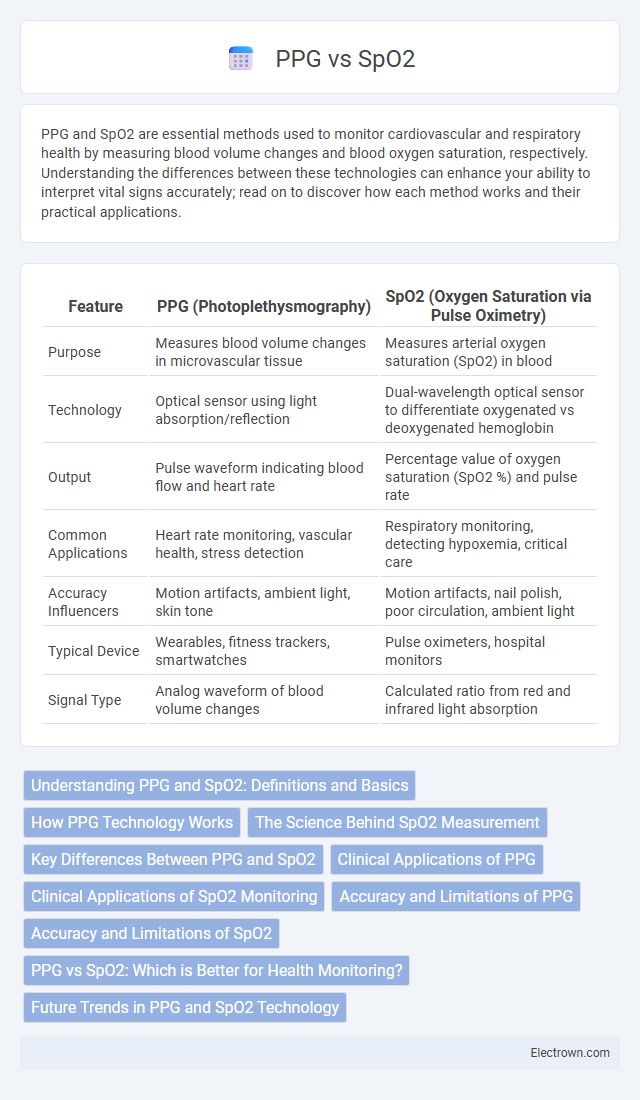PPG and SpO2 are essential methods used to monitor cardiovascular and respiratory health by measuring blood volume changes and blood oxygen saturation, respectively. Understanding the differences between these technologies can enhance your ability to interpret vital signs accurately; read on to discover how each method works and their practical applications.
Table of Comparison
| Feature | PPG (Photoplethysmography) | SpO2 (Oxygen Saturation via Pulse Oximetry) |
|---|---|---|
| Purpose | Measures blood volume changes in microvascular tissue | Measures arterial oxygen saturation (SpO2) in blood |
| Technology | Optical sensor using light absorption/reflection | Dual-wavelength optical sensor to differentiate oxygenated vs deoxygenated hemoglobin |
| Output | Pulse waveform indicating blood flow and heart rate | Percentage value of oxygen saturation (SpO2 %) and pulse rate |
| Common Applications | Heart rate monitoring, vascular health, stress detection | Respiratory monitoring, detecting hypoxemia, critical care |
| Accuracy Influencers | Motion artifacts, ambient light, skin tone | Motion artifacts, nail polish, poor circulation, ambient light |
| Typical Device | Wearables, fitness trackers, smartwatches | Pulse oximeters, hospital monitors |
| Signal Type | Analog waveform of blood volume changes | Calculated ratio from red and infrared light absorption |
Understanding PPG and SpO2: Definitions and Basics
Photoplethysmography (PPG) is a non-invasive optical technique that measures blood volume changes in the microvascular bed of tissue using light absorption. Peripheral capillary oxygen saturation (SpO2) represents the percentage of oxygen-saturated hemoglobin relative to total hemoglobin in the blood, typically estimated through PPG sensors at the fingertip or earlobe. The core distinction lies in PPG providing raw pulse wave data, while SpO2 uses this data to calculate blood oxygen levels.
How PPG Technology Works
Photoplethysmography (PPG) technology operates by emitting light into the skin and measuring the amount of light either absorbed or reflected by blood vessels, providing real-time data on blood volume changes. Unlike SpO2 sensors that primarily focus on oxygen saturation, PPG captures pulse rate and vascular health by detecting variations in light absorption related to blood flow. The optical signals generated by PPG sensors enable continuous, non-invasive cardiovascular monitoring through simple skin contact.
The Science Behind SpO2 Measurement
SpO2 measurement relies on pulse oximetry, which uses photoplethysmography (PPG) to detect oxygen saturation in the blood by emitting light wavelengths through tissue and analyzing light absorption differences between oxygenated and deoxygenated hemoglobin. The PPG sensor captures pulsatile arterial blood flow variations, enabling calculation of arterial oxygen saturation (SpO2) through the ratio of red and infrared light absorption. This non-invasive, real-time monitoring technique provides critical insights into respiratory and cardiovascular health by accurately reflecting blood oxygen levels.
Key Differences Between PPG and SpO2
PPG (Photoplethysmography) is a non-invasive optical technique used to detect blood volume changes in the microvascular bed of tissue, primarily measuring pulse rate and blood flow. SpO2 (Peripheral Capillary Oxygen Saturation) specifically quantifies the percentage of oxygen-saturated hemoglobin in the blood using pulse oximetry, a subset of PPG technology. Key differences include that PPG provides comprehensive cardiovascular information such as heart rate variability, while SpO2 focuses solely on oxygen saturation levels, making it crucial for monitoring respiratory and circulatory efficiency.
Clinical Applications of PPG
Photoplethysmography (PPG) offers versatile clinical applications, including monitoring heart rate variability, detecting vascular conditions, and assessing peripheral circulation in real-time. Unlike SpO2, which primarily measures blood oxygen saturation, PPG provides valuable insights into blood volume changes and arterial stiffness, aiding cardiovascular diagnostics. Your healthcare provider may leverage PPG's non-invasive and continuous monitoring capabilities for early detection of conditions like atrial fibrillation and peripheral arterial disease.
Clinical Applications of SpO2 Monitoring
SpO2 monitoring is essential in clinical settings for assessing a patient's oxygen saturation levels and detecting hypoxemia promptly. This non-invasive method provides critical data in anesthesia, intensive care, and emergency medicine, enabling healthcare providers to make timely interventions. Your ability to continuously monitor SpO2 ensures accurate evaluation of respiratory and cardiovascular function during surgery or critical illness management.
Accuracy and Limitations of PPG
PPG (photoplethysmography) measures blood volume changes and offers non-invasive monitoring but is less accurate than SpO2 (pulse oximetry) in assessing oxygen saturation due to susceptibility to motion artifacts, ambient light interference, and poor peripheral circulation. While SpO2 directly estimates oxygen saturation by analyzing light absorption at two wavelengths, PPG primarily tracks pulse and blood flow, limiting its reliability for oxygen level determination. Understanding these limitations helps ensure your health data is interpreted correctly, especially in clinical or high-precision settings.
Accuracy and Limitations of SpO2
SpO2 sensors use photoplethysmography (PPG) to estimate blood oxygen saturation by measuring light absorption in the skin, offering non-invasive and continuous monitoring. While SpO2 provides valuable data, its accuracy can be compromised by factors such as poor circulation, skin pigmentation, motion artifacts, and ambient light interference. Understanding these limitations helps you interpret SpO2 readings more effectively and assess when additional clinical evaluation may be necessary.
PPG vs SpO2: Which is Better for Health Monitoring?
PPG (Photoplethysmography) and SpO2 (Oxygen Saturation) are crucial metrics for health monitoring, with PPG providing real-time data on blood volume changes and heart rate variability, while SpO2 specifically measures blood oxygen levels essential for detecting hypoxemia. Your choice depends on the health parameter most relevant to your needs; PPG is excellent for comprehensive cardiovascular monitoring, whereas SpO2 is vital for respiratory health assessment. Integrating both technologies offers a more complete picture of your overall health status.
Future Trends in PPG and SpO2 Technology
Emerging trends in PPG (photoplethysmography) and SpO2 (peripheral capillary oxygen saturation) technology emphasize integration with wearable devices for continuous, real-time health monitoring. Advances in AI and machine learning algorithms enhance accuracy in detecting cardiovascular irregularities and respiratory conditions using PPG and SpO2 data. Future developments include non-invasive, multi-parameter sensors that combine PPG with SpO2 for comprehensive biometric analysis in telemedicine and personalized healthcare.
PPG vs SpO2 Infographic

 electrown.com
electrown.com